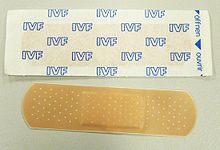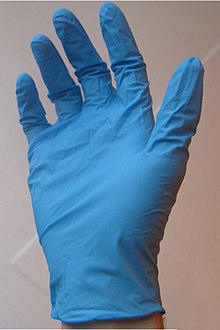First aid kit: Difference between revisions
→Typical contents: Moleskin— for blister treatment |
|||
| Line 28: | Line 28: | ||
***Burn dressing (sterile pad soaked in a cooling gel) |
***Burn dressing (sterile pad soaked in a cooling gel) |
||
*'''[[Bandages]]''' |
*'''[[Bandages]]''' |
||
''' |
|||
FAT KATE''' |
|||
== Headline text == |
|||
**Gauze roller bandages - absorbent, breathable, and often elastic |
**Gauze roller bandages - absorbent, breathable, and often elastic |
||
**Elastic bandages - used for sprains, and pressure bandages |
**Elastic bandages - used for sprains, and pressure bandages |
||
Revision as of 17:14, 5 September 2008

A first-aid kit is a collection of supplies and equipment for use in giving first aid. First-aid kits contain a variety of equipment that may include bandages for controlling bleeding, personal protective equipment such as gloves, a breathing barrier for performing EAR (expired air resuscitation) and CPR (cardiopulmonary resuscitation), and sometimes instructions on how to perform first aid.
Types
There are 2 types of first aid kits:
- Homemade first aid kits which are composed at home
- Commercial kits which are simply bought from companies as Care Plus, ...
Contents
Commercially available first aid kits available via normal retail routes have traditionally been intended for treatment of minor injuries only. Typical contents include adhesive bandages, regular strength pain medication, gauze and low grade disinfectant.
Specialized first aid kits are available for various regions, vehicles or activities. For example, first aid kits sold through marine supply stores for use in watercraft may contain seasickness remedies. Also, regions where malaria exist require antimalaria drugs, ...
Determining the right commercial kit may be done trough the sources as the EU-website Myfirstaidkit.eu. To make your own special first aid kit, guide books, certain websites (such as CDC.gov) and other literature may be used.
Typical contents



- Dressings (sterile, applied directly to wound)
- Pads
- Sterile eye pads
- Sterile gauze pads
- Sterile non-adherent pads
- Burn dressing (sterile pad soaked in a cooling gel)
- Pads
- Bandages
FAT KATE
Headline text
- Gauze roller bandages - absorbent, breathable, and often elastic
- Elastic bandages - used for sprains, and pressure bandages
- Adhesive, elastic roller bandages - very effective pressure bandages or durable, waterproof bandaging
- Triangular bandages - used as slings, tourniquets, to tie splints, and many other uses
- Adhesive bandages (band-aids, sticking plasters)
- Straight adhesive bandages
- Moleskin— for blister treatment
- Butterfly (knuckle) bandages and wound closure strips
Instruments
- Adhesive tape, hypoallergenic
- Trauma shears, for cutting clothing and general use
- Tweezers
- Lighter, for sterilizing tweezers or pliers etc
- 20-cc syringe with catheter tip for wound irrigation with sterile saline solution
- Rubber suction bulb, for clearing the airway of an unconscious patient
Equipment
- Personal Protective Equipment (PPE)
- Gloves, disposable non-latex
- CPR mask or other breathing barrier such as a face shield
- Scissors
- Eye cup or small plastic cup
- Torch (also known as a flashlight)
- Instant-acting chemical cold packs
- Sterile eye wash (commonly saline)
- Sterile saline (used for cleaning wounds where clean tap water is not available, but note that even clean tap water should be converted to normal saline by adding salt)
- Swabs, sterile non-woven
- Space blanket (lightweight plastic foil blanket, also known as "emergency blanket")
- Alcohol rub (hand sanitizer) or antiseptic hand wipes
- Thermometer
- Penlight
Medication
- Antiseptics/antimicrobial
- Povidone iodine wipes (use for first-aid disputed)
- Benzalkonium Chloride (use for first-aid disputed)
- Alcohol pads - used to prep unbroken skin for injections etc. or to disinfect equipment such as thermometers.
- Antibiotic pills (use for first-aid disputed)
- Antibiotic ointment - single, double, or triple antibiotic ointment in petroleum jelly base (use for first-aid disputed)
- Antiseptic/anesthetic ointment, fluid or spray, for example Lidocaine
- Anti-fungal cream
- Anti-itch ointment
- Hydrocortisone cream
- Calamine lotion
- Painkillers / fever reducers
- Acetaminophen
- Ibuprofen - anti-inflammatory, often more effective than acetaminophen.
- Aspirin
- Anti diarrhea medication such as Loperamide Immodium
- Oral rehydration salt
- Antihistamine
- diphenhydramine (brand name Benadryl)
- Aloe vera gel - used for a wide variety of skin problems, including burns, sunburns, itching, and dry skin; used as a substitute for triple-antibiotic gel to keep a wound moist and prevent bandages from sticking
- Burn gel - a water-based gel that acts as a cooling agent and often includes a mild anesthetic such as lidocaine and, sometimes, an antiseptic such as tea tree oil
- Epinephrine auto-injector (brand name Epipen) - often included in kits for wilderness use and in places such as summer camps, to treat anaphylactic shock.
- Poison treatments
- QuikClot is a hemostatic agent sometimes included in first aid kits, especially military kits, to control severe bleeding.
- Tincture of benzoin— improves tape adhesion to skin, toughens cracked skin
Improvised uses
Besides its regular use in first aid, many first-aid items can also have improvised uses in a survival situation. For example, alcohol pads and petroleum jelly-based ointments can be used as a fire-starting aid in an emergency, and the latter can even be used as an improvised lubricant for certain mechanical devices, and adhesive tapes and bandages can be used for repairs. These alternate uses can be an important consideration when picking items for a kit that may be used in wilderness or survival situations. An alternative could however also be the use of additional kits with tools such as Survival kits and Mini survival kits.
Trauma Bag/First Responder Bag
Emergency responders use a more advanced medical kit called a trauma bag or a first responder bag containing greater quantities of material, of higher quality, than commercially available first aid kits.
Markings

Commercially available first aid kits sold in North America and Europe are generally identified by one of the following symbols:
- Red Cross
- Green Cross
- Red Star[citation needed]
- St.John Ambulance
The use of the Red Cross on First Aid kits by anyone but the International Committee of the Red Cross (ICRC) or associated agency may be illegal under the terms of international agreements designating the red cross as a protected symbol. The red cross is also a registered trade mark of the ICRC. Johnson & Johnson has permission to use the red cross as a trademark on its products and registered the symbol for use in 1887.
